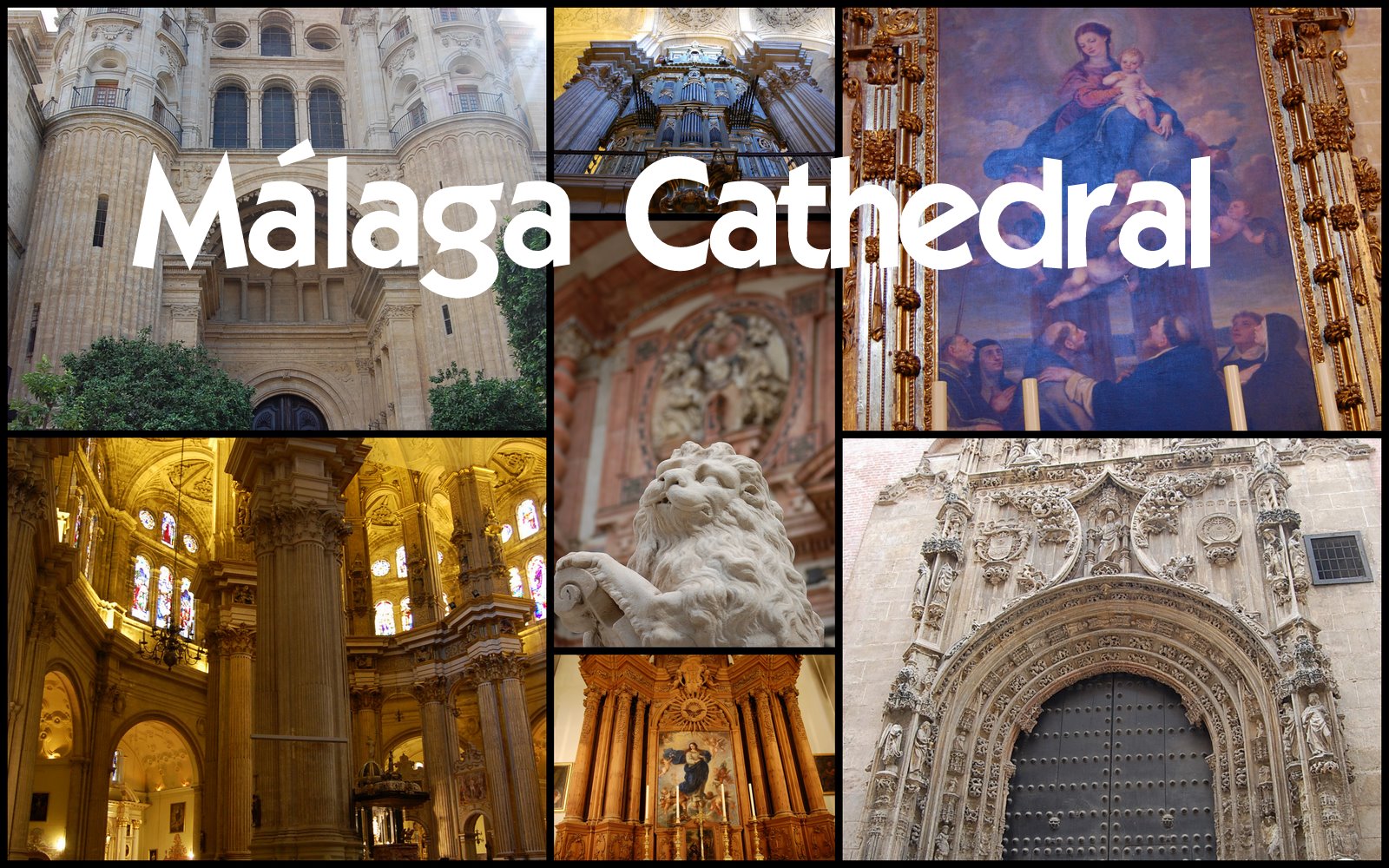Málaga's Cathedral replaced a Moorish mosque which
itself replaced a Christian basilica of the Visigoths.
(This is the usual pattern as early bishops tended to get
the best real estate.) When Ferdinand and Isabel took
Málaga on August 18th, 1487, they first had the
mosque undergo the standard Christian ceremony to convert
it to a church.
A work in progress
By 1500, work was in place to create a proper cathedral
but first attempts were abandoned for a 1528 kickoff
based upon a design by a famous Andalusian cathedral
architect Diego de Siloe. (His Granada cathedral is one
of the masterpieces of the Spanish Renaissance.) Two
widely separated building efforts give us the still
unfinished cathedral we see in these pictures: The first
in the early 16th century and the conclusion in the 18th
century.

The Wiki picture above shows that the Diego de Siloe's
overall layout is a Gothic cross with short transepts and
the top of the "T" in a typical rounded apse. But instead
of vaults, we see a collection of 12 domes in the nave
with its larger center aisle. At the top right, you'd
expect to see a second bell tower, balancing the first.
More on that missing tower later.
Styles that influenced De Siloe were the Gothic and
Arabic that surrounded him as well as the Italian
Renaissance he experienced during a stay in Naples.
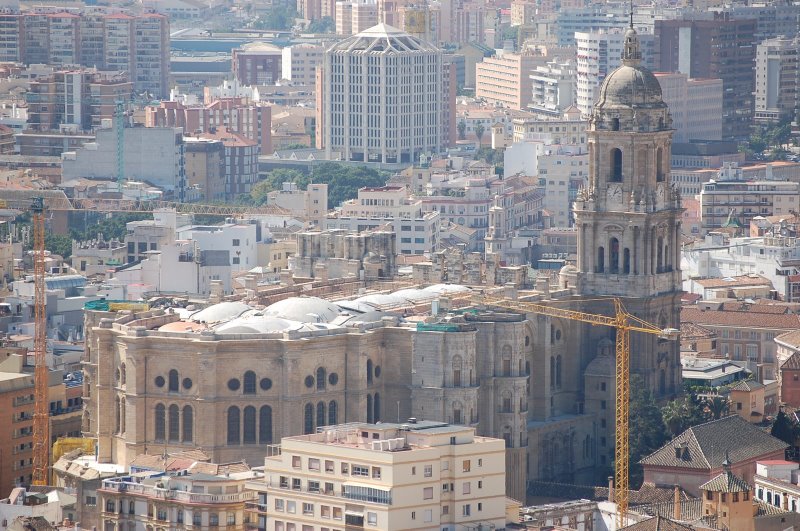
Here we see the stub of the unfinished South tower
which gives the cathedral its nickname of "La Manquita,"
the one-armed one. Building was financed through taxes on
the iron ore exported at the nearby harbor; but during
the American Revolution, work stopped on the South
tower in 1782 while the funds were diverted to
support that war effort. Those colonial upstarts
took on Spain's great enemy -- the British
Empire.
Andalusia's second great Renaissance architect,
Andrés de Vandelvira, who made Úbeda
and Baeza into limestone jewels, also assisted here.
The single tower
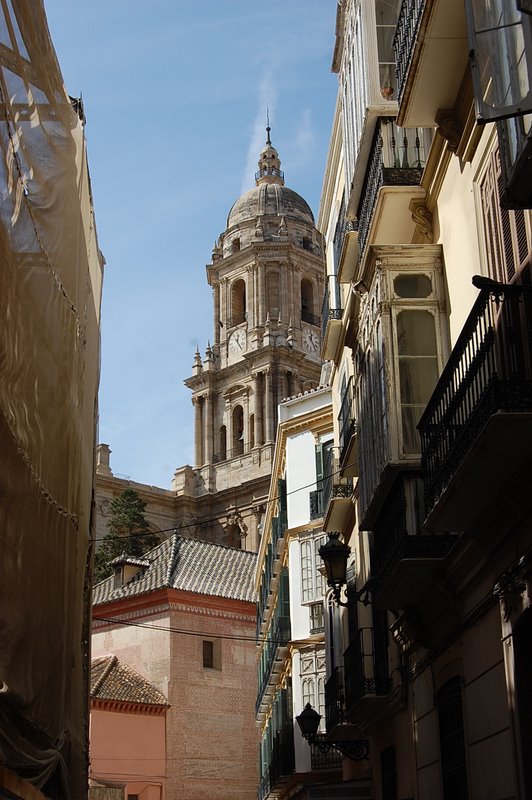
The tower that is not missing is part of the Baroque
facade added in the 18th century onto the primarily
Renaissance exterior. While Málaga's high-rise
buildings now dwarf it, at 276 feet, this is the tallest
cathedral tower in Andalusia except for the Giralda in
Seville.
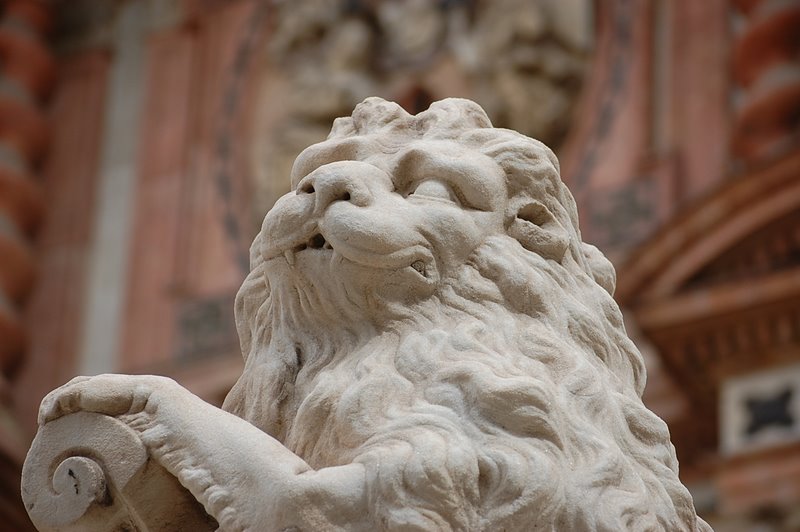
A gratuitous statue shot at the cathedral's baroque
facade.
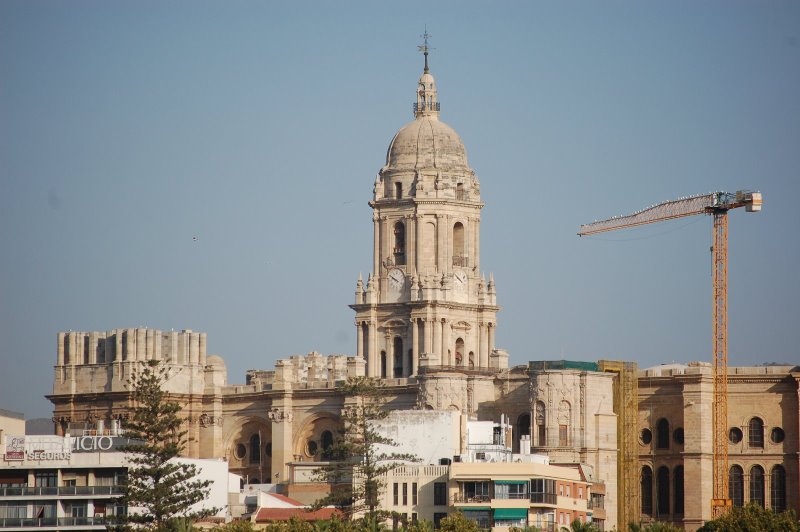
Today, Malagueños debate whether to complete the
South tower or to leave it, like Schubert's 8th symphony,
unfinished. (This might B a minor argument anywhere else.
Proponents say cathedrals take a long time to build and
finishing it now would mean this would be a 5 century
build. In these Web 2.0 days, viewers can vote their
preferences. What would Diego de Silo do?)
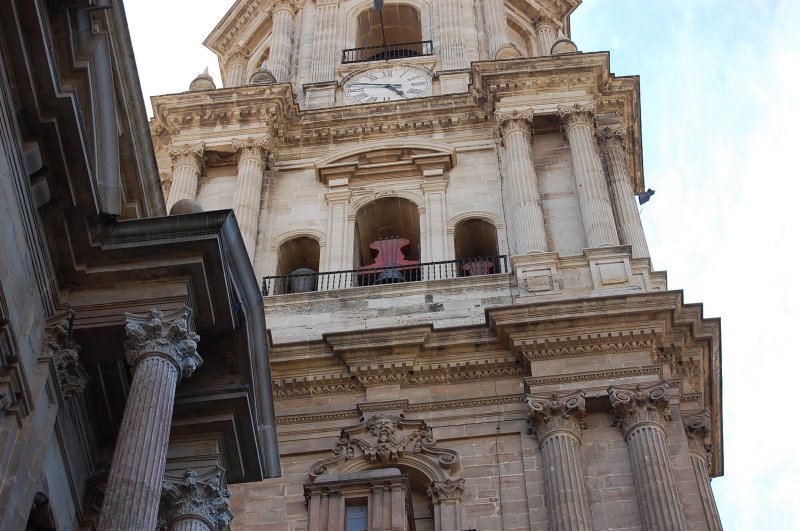
No shortage of Corinthian capped pillars here on the
facade.
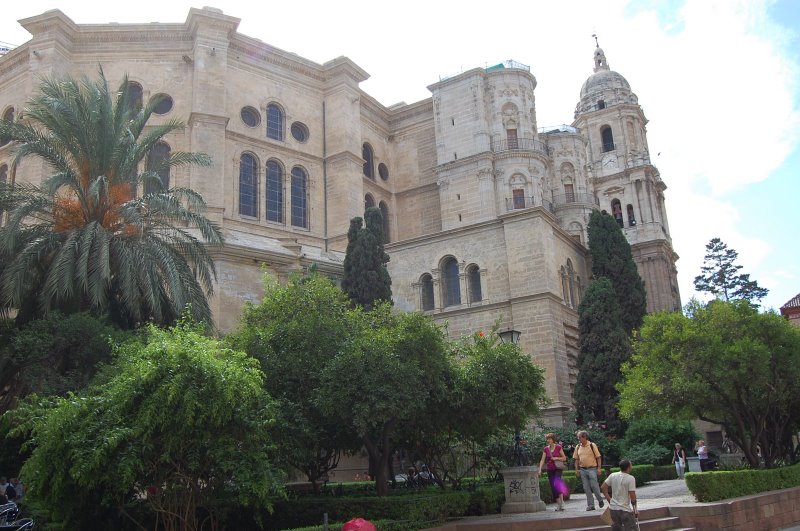
Except for the baroque facade, the exterior is
Renaissance. Here we have the half-circular apse at left
and the Gospel-side transept.
The Interior
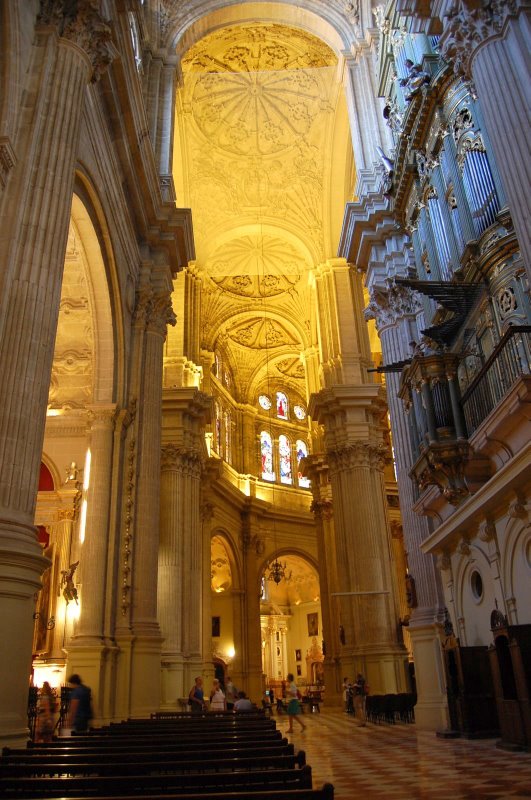
The same view of the curving apse from the inside which
is primarily Renaissance. Notice rising on the right
is...
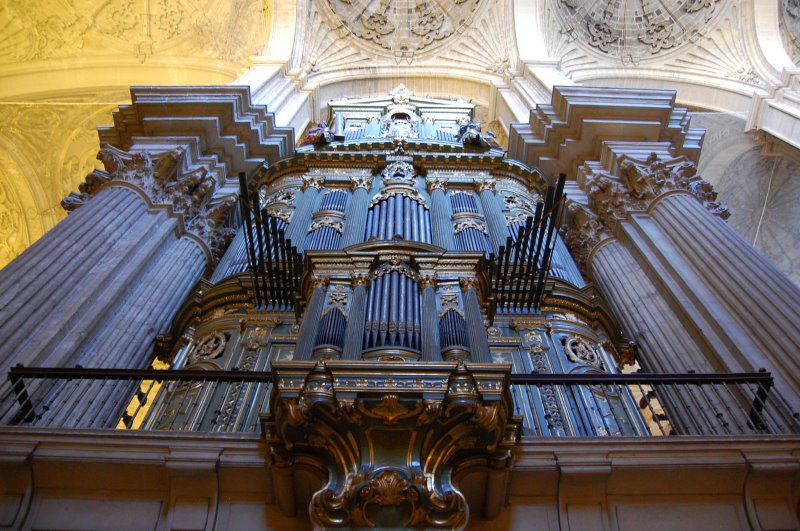
... one of the Baroque organs between long pillars with
elegant Corinthian capitals reminiscent of those designed
by the 14th century Italian Brunelleschi (who is best
known for putting the egg-shaped dome on Florence's
cathedral).
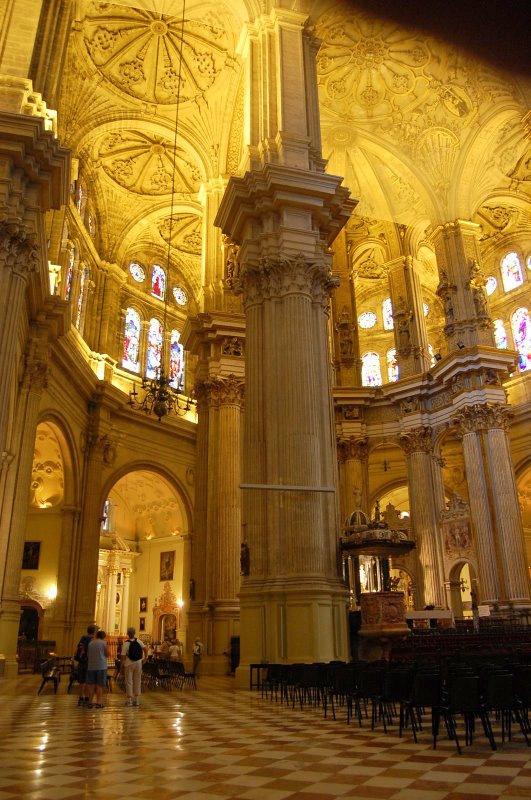
Some consider Diego de Siloé to be Spain's first
Renaissance architect. He started as a sculptor and his
cathedral houses some outstanding woodcarvings (although
not by him.) His father was probably a Flemish Sculptor
and Diego himself was schooled in the Italian Renaissance
during a stint in Naples (which was part of the Spanish
Empire at that time.)
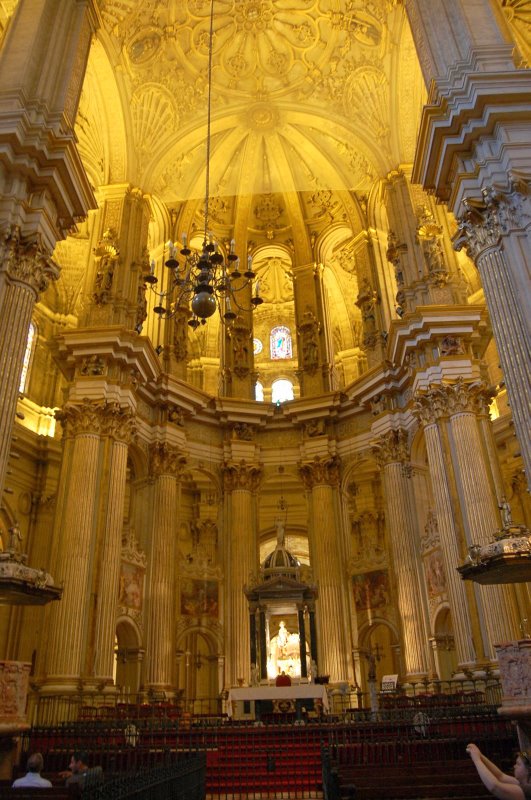
The main altar is flanked on both sides by elaborate
marble pulpits.
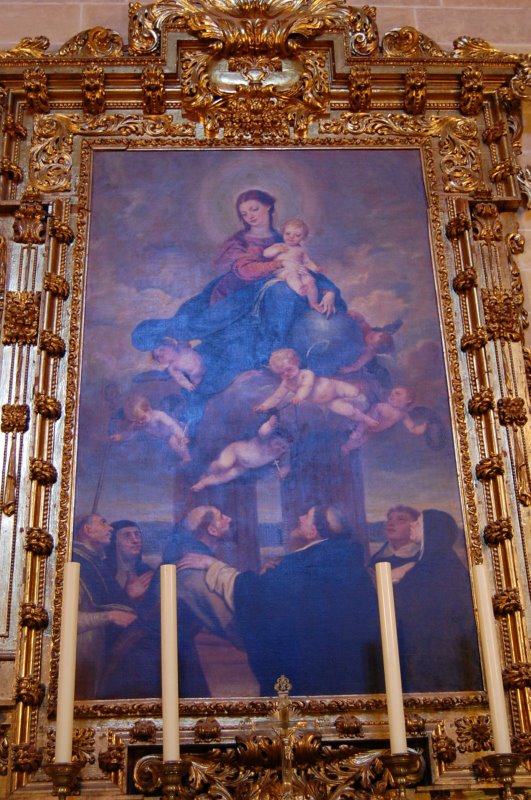
Perhaps the most famous painting here is the Immaculate
Conception by troubled Andalusian artist Alonso Cano.
Check out the cherub at far left hitting the bishop on
the head with his own crosier.

The inset is the Dolorosa (Sorrowful Mother) by Pedro de
Mina (who also did the cathedral choir which we will see
in a minute.) The sculptor was highly influenced by the
expressions he saw in Alonso Cano's work.
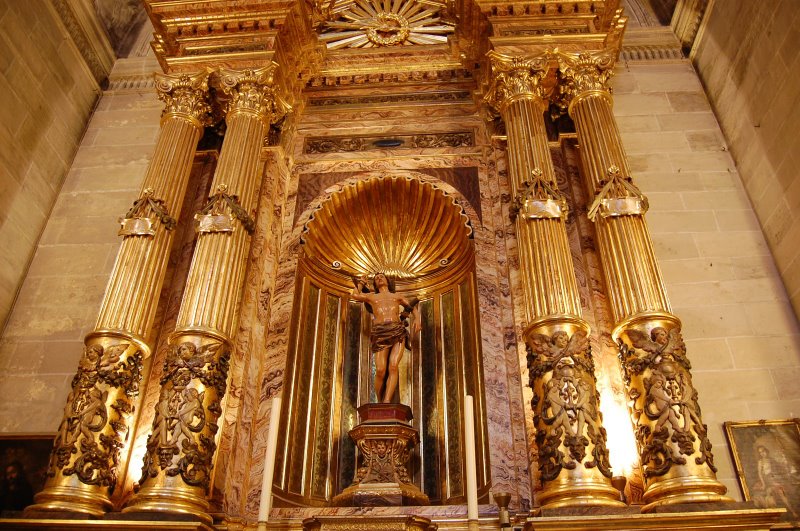
The chapel of San Sebastian contains this 17th century
statue by Jeronimo Gomez.

At center is the 1802 Pietra by the Pissani brothers.
Salvador León's 19th century Mary Magdalene is at
left. It looks marble but is, in fact, wooden.
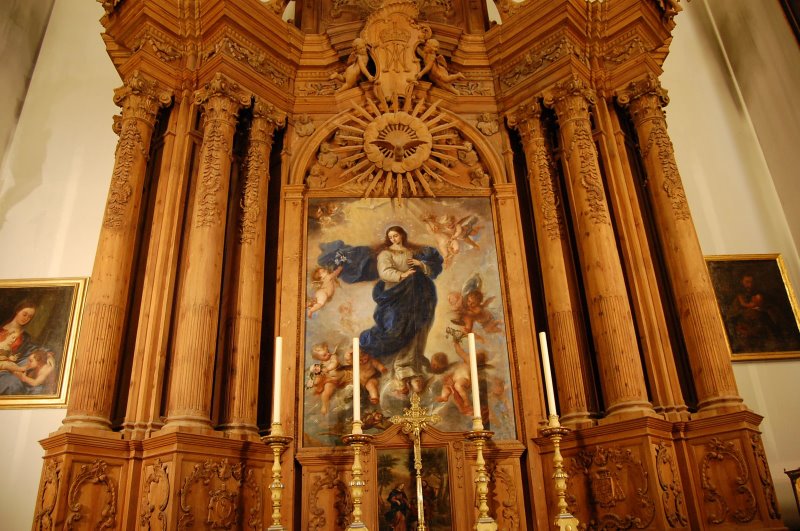
Claudio Coellio's 17th century Immaculate Conception is
nicely framed by sets of Baroque pillars.
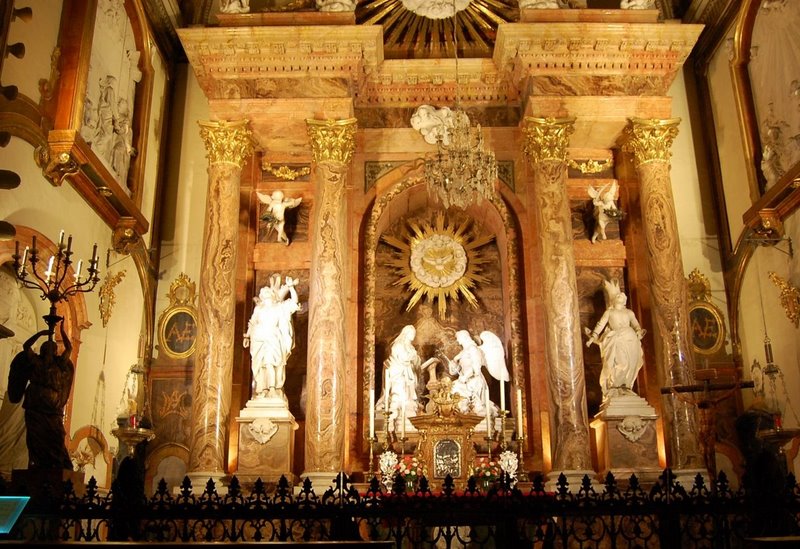
The Chapel of the Incarnation (namesake of the cathedral)
shows a neoclassical altarpiece designed in 1785 by Juan
de Villanueva...
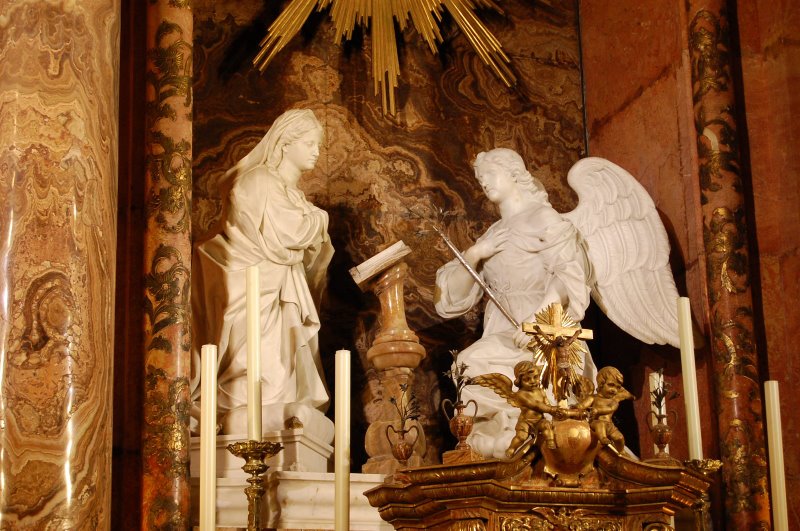
... and carved by Antonio Ramos and Aldehuela with
sculptures and Palomino Salazar.
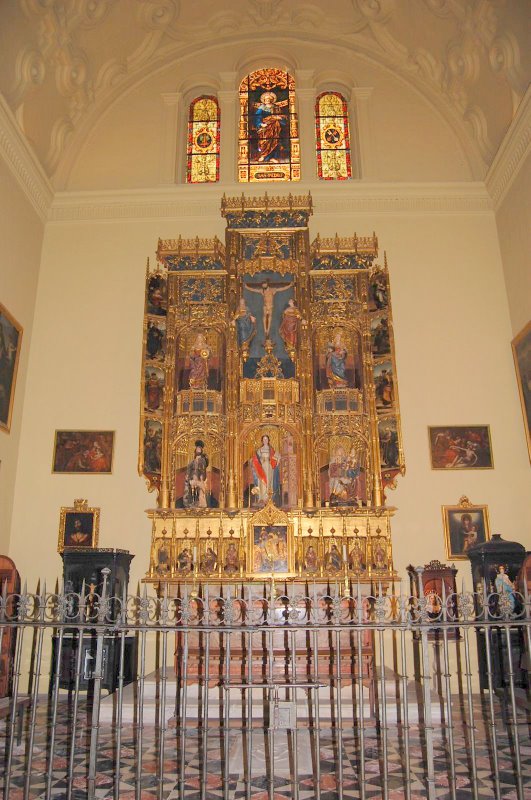
This Flemish Gothic retable is in the Chapel of San
Barbara.
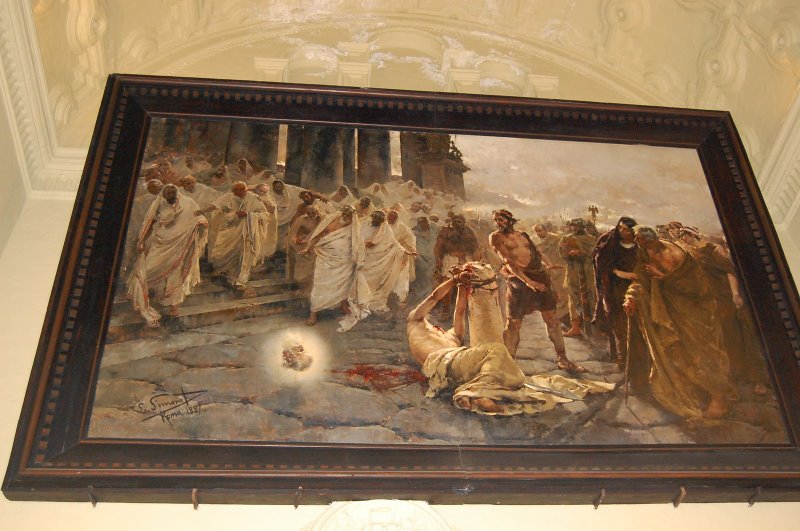
A final painting: this gruesome depiction of the
beheading of the Jewish prophet John the Baptist upon
orders from Herod Antipas.
Pedro de Mena's Baroque choir
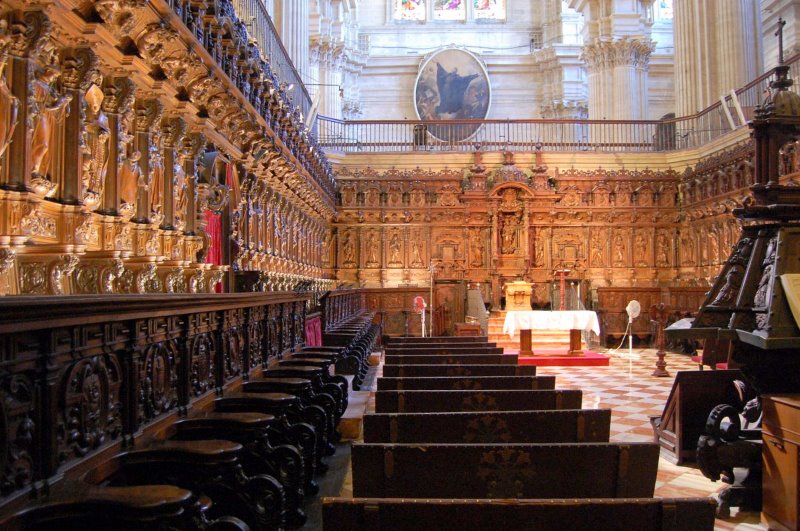
Let's end our visit of the cathedral interior with the
outstanding choir carved by the 17th century baroque
sculptor Pedro de Mena. He finished the job started 28
years earlier by sculptor Jaén Luis Ortiz de
Varga.
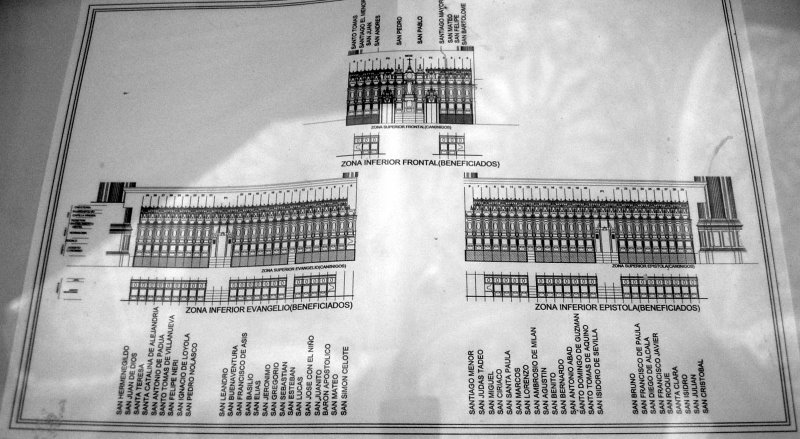
Signage is good (and multilingual) inside the cathedral.
But for someone with a fetish for cathedral detail, this
is my favorite sign in all of Andalusia: all the icons
carved on the choir stalls are charted with Peter and
Paul at top: If you've got the time, we've got the saint!
The cathedral chapter (which would meet in these chairs)
dictated the list of saints to the sculptors.
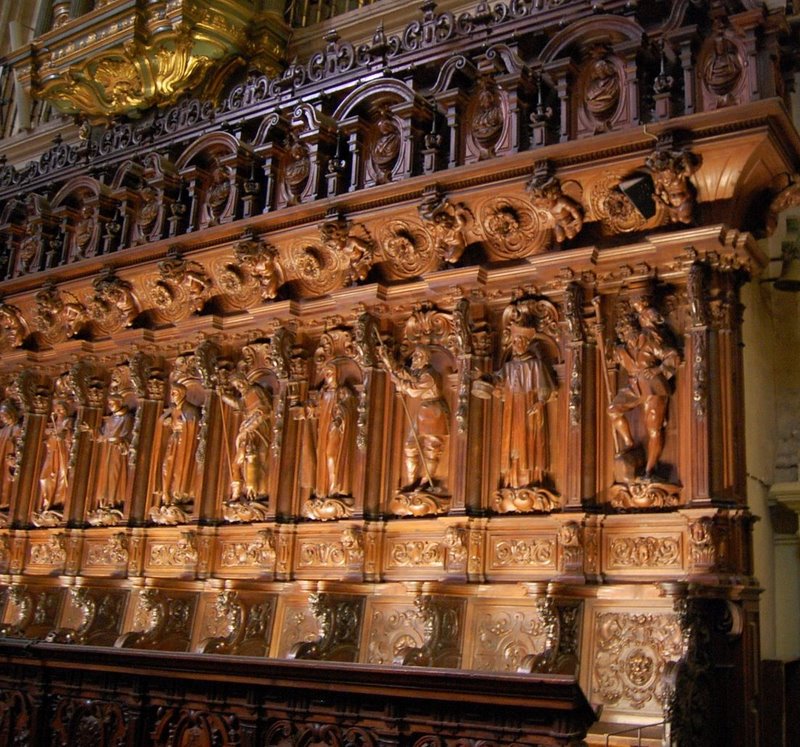
You can't tell the players without a scorecard! Per the
preceding chart, we see Saint Christopher on the far
right. The Catholic calendar quit venerating him in 1969
but he remains here raising the Christ child on his
shoulders. In the next century, the important Spanish
painter Antonio Palomino would call this 1658 choir "the
8th wonder of the world." Obviously he had never visited
Houston's Astrodome.
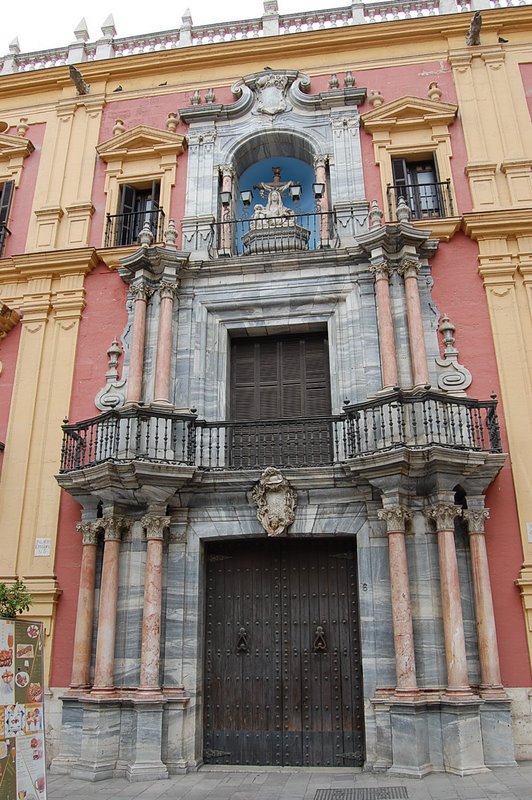
Let's look at a few areas more-or-less attached to the
cathedral. Above is the former bishop's palace across the
street from the Cathedral sharing the Plaza del Obispo.
This Baroque gray doorway with its pink Corinthian
pillars and 3rd floor Pieta is from the 18th century.
Inside, American architect Richard Gluckman has converted
it to an exhibition museum. Its opening show was on
Picasso - a bit of coals to Newcastle as he has a whole
museum dedicated to him in this town of his birth.
Cathedral environs
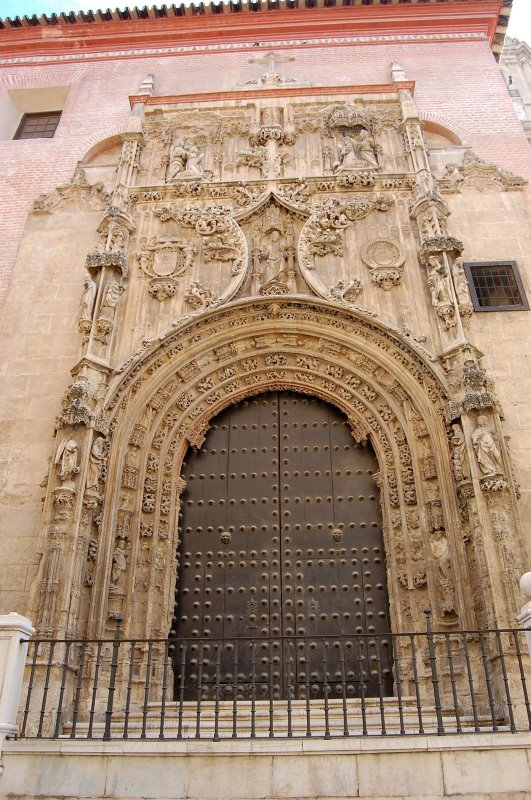
In the cathedral gardens stands a smaller church called
"el Sagrario" with this elaborate Isabelline Gothic
portal called the Door of Pardon (Puerta del
Perdón). This appears to be the remnants of the
mosque -- with this Christian doorway added. The rest of
the mosque was torn down in the early 16th century to
create room for the present cathedral. Despite its Gothic
structure, it's attributed to Diego de Silo who laid out
the Renaissance interior of the cathedral.
The top row contains carving of the two bishops who
funded it. God the Father holds the center, holding a
globe of the world between seals and coats-of-arms of
bishops. Like a good Gothic portico, it is filled with
saints' statues including here the Evangelists, Gabriel,
Mary, and even a few Old Testament prophets.
Galvez? si, Galvezton? maybe
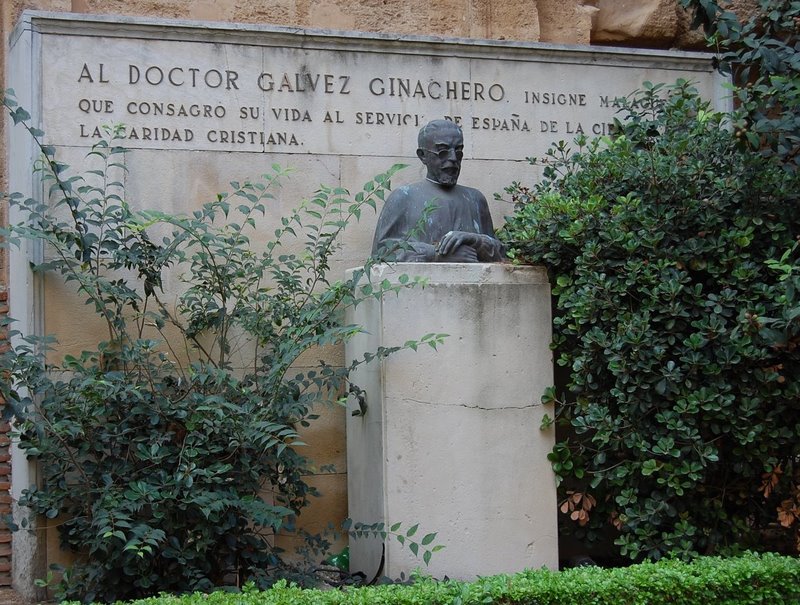
Here's a bit of local color clinging to an exterior wall
of the cathedral: a statue of Málaga 's one time
mayor and long-time gynecologist, José
Gálvez Ginachero. Tour guides here claim Galveston
Island in Texas was named for him. He must have also been
a time traveler -- the rascal Jean Lafitte and a band of
pirates built on that Texas site 50 years before this
Gálvez was born.
This would also surprise Bernardo de Gálvez y
Madrid, Count of Gálvez and governor of Louisiana
at the time of the American Revolution. His troops first
captured that island from the mosquitoes (the insects,
not the Indians) in 1777. That Gálvez greatly
helped those rebellious Americans by fighting the Brits
throughout the deep South in hopes of getting Florida
back (which he did.) Were it not for him, we might all be
speaking English on this side of the Atlantic.
At least both Senors Gálvez are natives of
Málaga province.
Brits now thrive on Spain's Costa del Sol, making up for
losing Florida. We could speculate that more English is
spoken here than in Miami.
Let's now visit the birthplace of another famous
Malagueño named Picasso. Join us
by clicking here.
If you have good bandwidth, Please join us in
the following slide show to give the
Málaga, Spain the viewing it deserves by clicking here.
|
|
